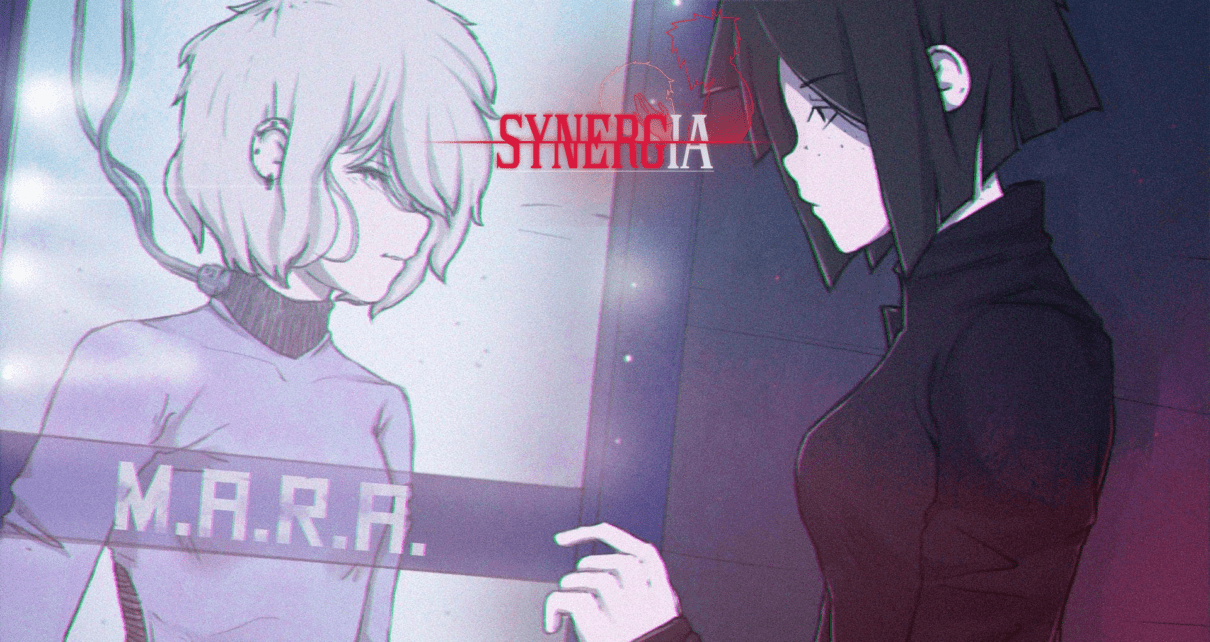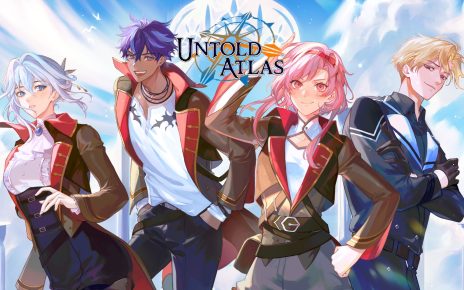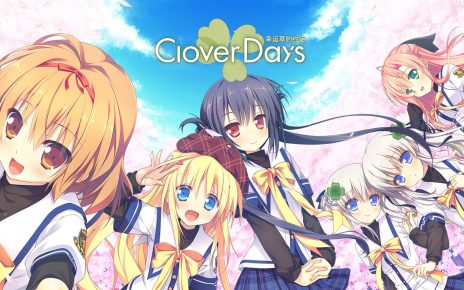Released on 27 July 2020 for PC and more recently, on 18 March 2021 for Playstation 4/5 and Nintendo Switch, Synergia is a cyberpunk thriller visual novel developed by RadiArt and published by Top Hat Studios and Eastasiasoft (Switch). Set in an imperial state where love between humans and androids is outlawed, the story follows the difficult but blossoming romance between Cila, a veteran policewoman, and Mara, a female android.
With an ESRB rating of Mature 17+, this game has content warnings of blood, firearms, partial nudity, sexual themes, strong language, use of tobacco, and violence. Its opening video, which starts right after the logo splash screen, contains flashing images and glitch effects, but players may skip the video entirely by pressing the “Enter” key (PC) as it begins to play. Within the game itself, there is no flashing animation used but there are screen shakes and aesthetics involving neon red color.
Currently, Synergia is available in English, simplified Chinese, and Spanish. For this spoiler-free review, the English PC version is played and discussed.
World-building: Hello, Bohemius!
Cyberpunk is a science fiction sub-genre that focuses on a technologically advanced but dystopian future. Naturally, being a cyberpunk story, Synergia has both the “cyber” and “punk” elements represented in its world, even though some things could have been made clearer.
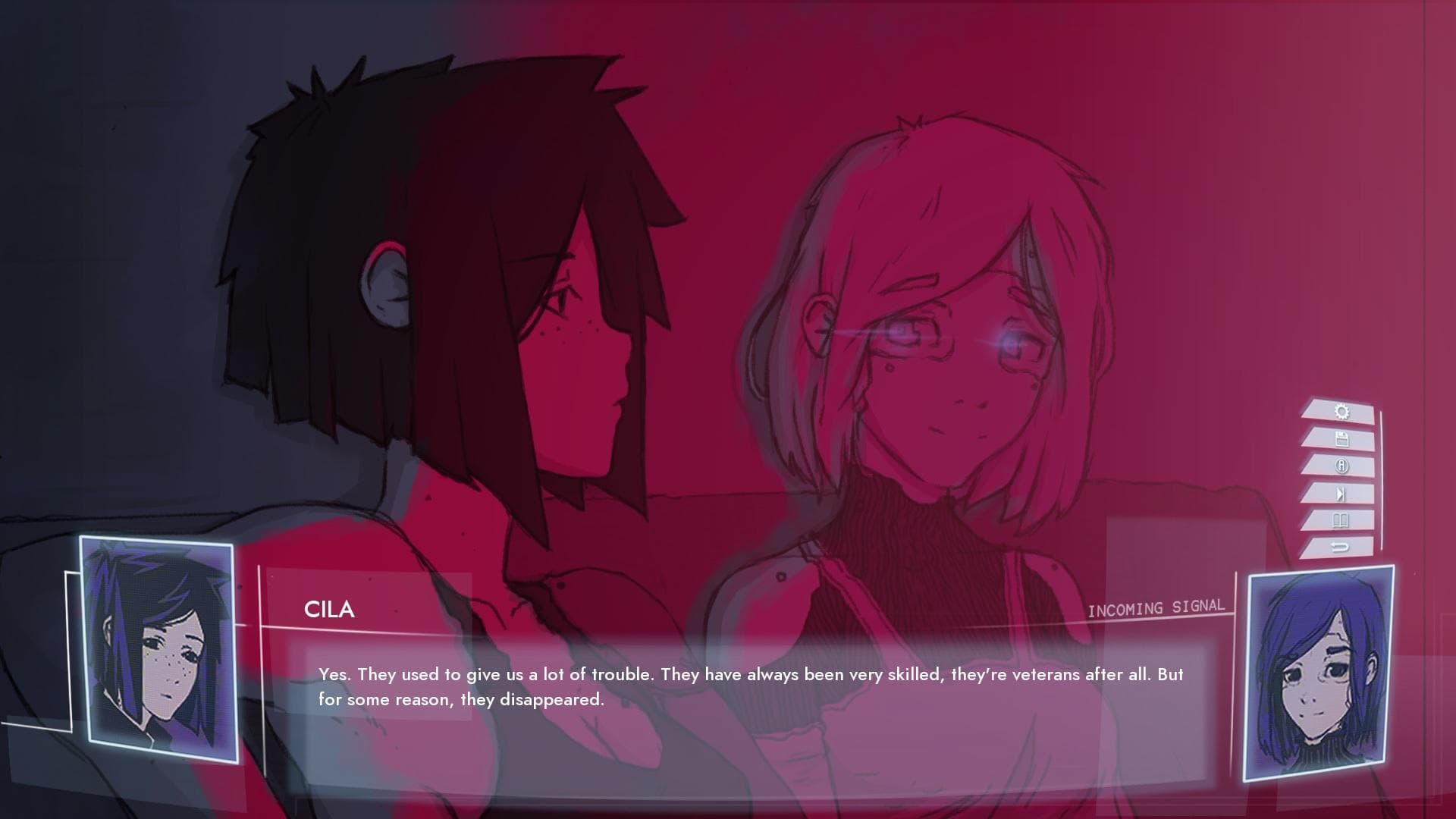
In Synergia, we step into Bohemius, a district of a city in an imperial state. Apart from the androids and cyborgs that are part of the population, there are cloud generators, floating trains, virtual reality chat rooms, and of course, the signature neon lights. We are also reasonably grounded to familiar reality with the presence of televisions, radios, and cars.
As for the dystopian side, they are noted via everyday conversations and sources like news channels. Mentions of the Empire, anti-imperial rebels, big corporations, android haters, terrorists, and other crime syndicates can be seen throughout the story. Clearly, plenty of tension is brewing in Bohemius but what is not so clear is their impact on Cila’s story itself, besides being there to fulfill the world’s state of affairs as needed for a cyberpunk genre. Sure, the Empire’s law that forbids love between humans and androids directly impacts Cila and Mara, but other issues seem to just fly past them. For instance, I find it strange that the two could casually talk about one of the big tech companies and some classified information while traveling on a public floating train. Even if the train had no one else on board, I would have assumed people living in a tension-filled futuristic society would be more cautious with what they disclose in public lest there are spies. For a member of the police force, Cila’s life just seems oddly detached from the prevailing chaos. Thus, while there are irrefutable dystopian elements introduced, I find it a wasted opportunity that they are not integrated more meaningfully into the main story.
Besides writing, art is the other major format through which the world of Synergia is presented. Background (BG) art provides the most direct illustration of various places in Bohemius. There are over twenty locations depicted and they generally have a good mix of both the high-tech areas and less developed regions. The use of colors in the BG art is excellent; lovely lights may decorate the venues but there is always a layer of dreariness and coldness felt. Many locations also feature confined spaces, a cleverly veiled reflection of the suffocation and repression experienced by some of the Empire’s citizens.
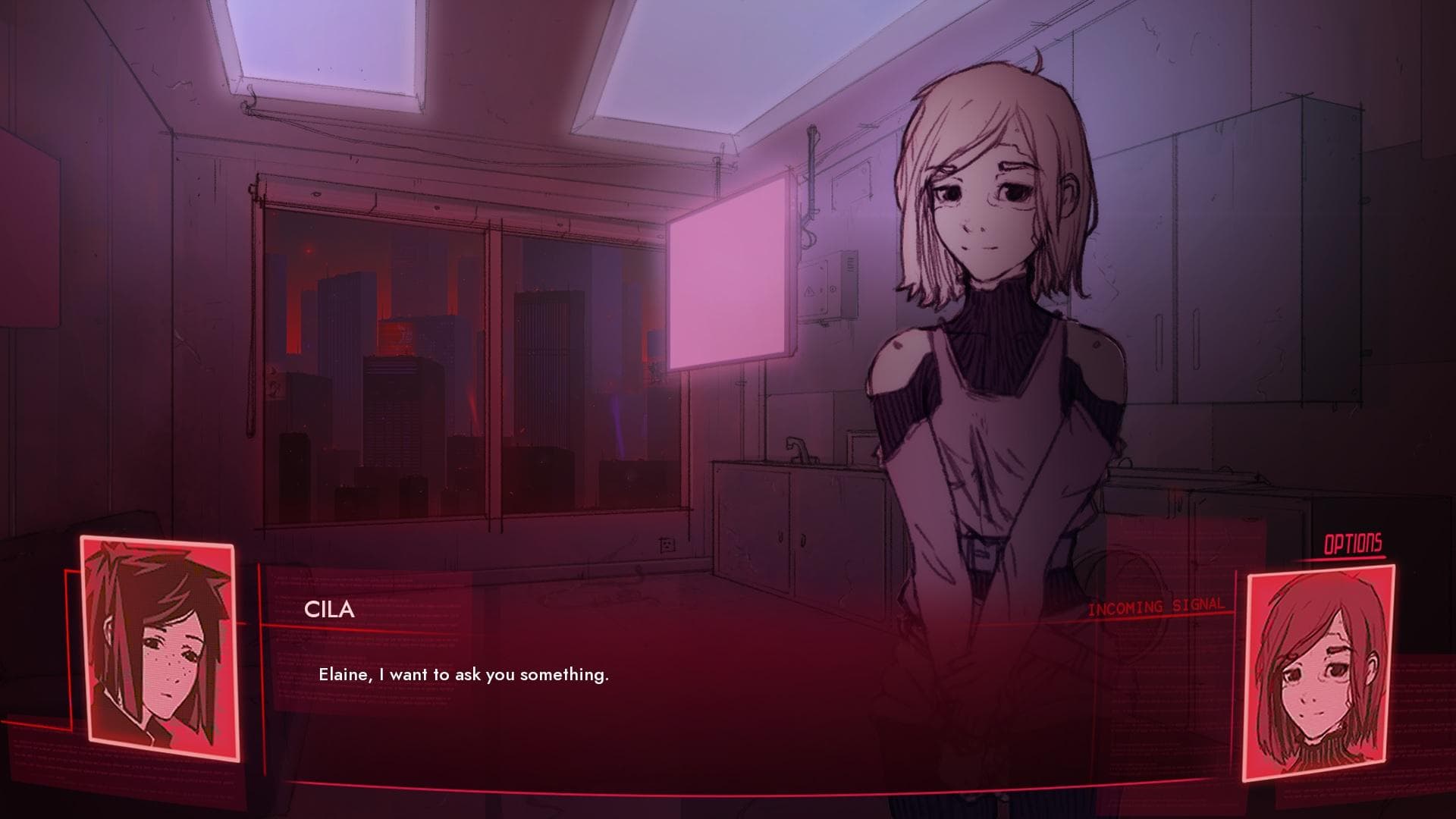
Much to my amazement, the user interface (UI) has been meticulously designed to work seamlessly with the futuristic setting of the story, so much so that it can be easily embraced as a part of the world. Dialogue texts are shown in a slightly curved textbox that resembles an LED screen. Character portraits are placed at either end of the textbox and the portrait of the current speaker will be highlighted. In addition to being a wonderful visual cue for players to quickly tell who is speaking and who is not, these portraits are reminiscent of profile photos on social media. In-game options are tucked right above the right portrait space. Clicking on it will open a sleek vertical menu with icons pointing to various functions: settings, save, auto-forward, skip, history log, and return. All these little design details combined allowed the textbox to give players a perception that they are viewing text messages through a pair of smart glasses. This perception is further reinforced during incoming calls, where a banner indicating the caller’s name pops in from the right end of the screen.
Outside of the game, the settings, save and load, and gallery screens are customized spectacularly as well. The settings screen looks like a computer terminal, save and load screens follow the idea of cloud storage data on different servers, and the gallery screen ties in with Cila’s profession to showcase images as collected evidence.
Fashion-wise, I am not familiar with what constitutes cyberpunk style but I have found most characters’ everyday getup looking kind of plain. Nevertheless, Yoko’s punkish attire, Venus’ stylish jacket with its neon green highlights, and Rat’s elegantly sexy outfit have certainly caught my eyes. Do not be fooled by the plain-looking clothes, however, as character designs are on the whole well-done. There is an assortment of hairstyles, eye shapes, and oftentimes accessories considered to give every character a unique look that actually says something about their personality or background. Mara, for example, has large round eyes and a bob cut that remind me of a playfully mischievous child. And Yoko, when she first appeared, I could immediately guess that she is Japanese.
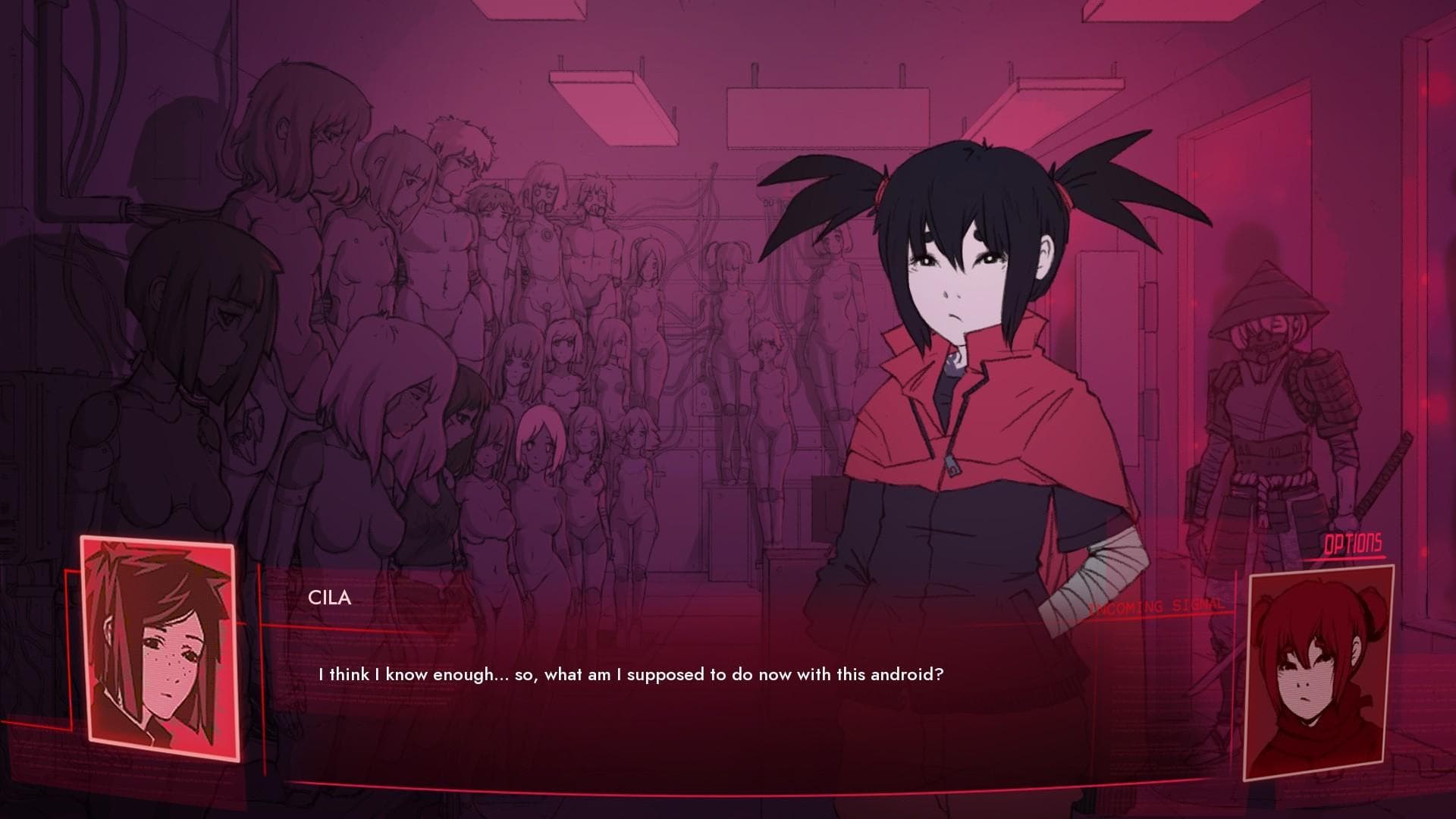
From the written dialogue and news outlets to the BG art and UI and character designs, Synergia does a great job at painting a multifaceted yet consistent cyberpunk world. Unfortunately, most of the world still feels like a standalone unit from Cila’s story. Also, taking into account that there are frequent mentions of terms that are either technical (e.g. protocell) or specific to the lore (e.g. Prothepam), the visual novel’s lack of an extra dictionary menu is a huge disservice to itself. After all, the presence of supplementary explanations for a highly specific world is always a good thing, given that it often helps improve understanding and appreciation for the details put into the fictional world.
Characters: Complex individuals, intricate relationships.
Character design is not the only thing that gives the characters their personalities. There is much to learn about everyone — main and side characters alike — through both spoken and unspoken words. What I find particularly charming in the writing of these characters is how everyone has their own experiences and personalities that shape their views and convictions. Due to strong characterizations, it is easy for me to develop a clear liking or disliking towards most of the characters.
My top favorite character among Synergia’s cast is Yoko, Cila’s friend. I admire the maturity observed in Yoko’s friendship with Cila. The two may have conflicting values and views but they still respect each other’s boundaries, and Yoko, in particular, will continue to kick others’ asses for Cila. This wordless support for her longtime friend is deeply touching.
Mara did not stand out to me at first. In fact, I get quite annoyed by her mainly extroverted personality with her never-ceasing chats. Even so, I find myself warming up to Mara over the course of the story as she turns out to be a pretty cute character. Her devotion and bravery eventually won me over.
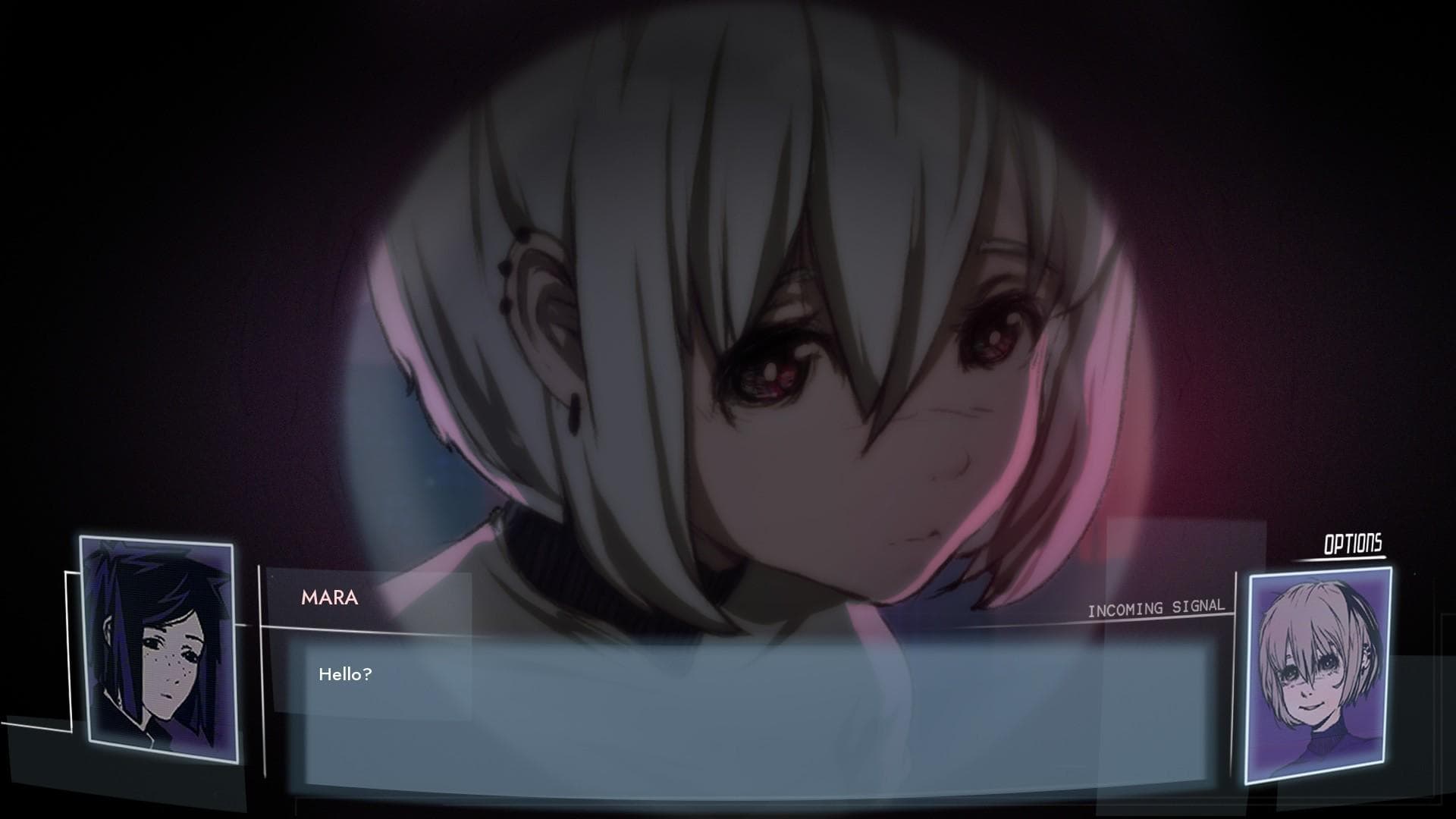
The protagonist of Synergia, Cila, is the only character whom I went from neutral to negative feelings for. In the beginning chapters, I sympathized with Cila and feel anger at the injustices she is facing at work. Reasonably expected for a cop, she holds the law in high regard and I can understand and even agree with her moral stances. What made me dislike Cila in the end is when I find her to be quite the passive individual and also one who complains a lot but could offer no alternative solutions. In the endings, the way she talks reminds me of people who speak from positions of privilege. She may have the more rational moral stance but she also tends to give a holier-than-thou impression and see things in a manner that is too black-and-white to my taste.
To some, Cila may seem like a wrong choice as a protagonist for a cyberpunk story since she is a police officer — where is the punk, right? However, the “punk” lies not in her occupation but the fact that she is going against the law anyway by falling in love with Mara. Because she is a cop, her breaking of the very law that she is supposed to uphold becomes a strikingly anti-authoritarian act. Therefore, it is a clever choice of the main character although Cila could really use more agency. I mean, this story is rightfully hers!
Whilst most characters in Synergia are well developed, almost all of the growth is devoted to Cila and the relationship between Cila and Mara. Cila’s struggles may not be explicitly spelled out but they are definitely there. One particularly powerful moment that speaks volumes is when Cila reels back from her sexual tension felt towards Mara. It is evident that Cila has several challenges to overcome before she can comfortably accept her own feelings, and watching this entire journey has been somewhat satisfying. Well, it is only somewhat satisfying as I find the crux of this lovers’ arc dampened by the rather rushed pacing felt during that part.
Story: It is not only about love.
Other than the arduous love between Cila and Mara, Synergia also touches on several intriguing themes. Androids versus humans is a significant topic that is constantly discussed from the start until the end. It sometimes branches briefly into more specific areas like religious beliefs and civil rights. Given Cila’s profession, there are a number of portions that deal with morality. Friendship and bonds are other themes prominently brought up through Cila and Yoko’s scenes. Nonetheless, there is a comparative lack of exposition regarding the major societal conflicts despite the existence of a dystopian world.
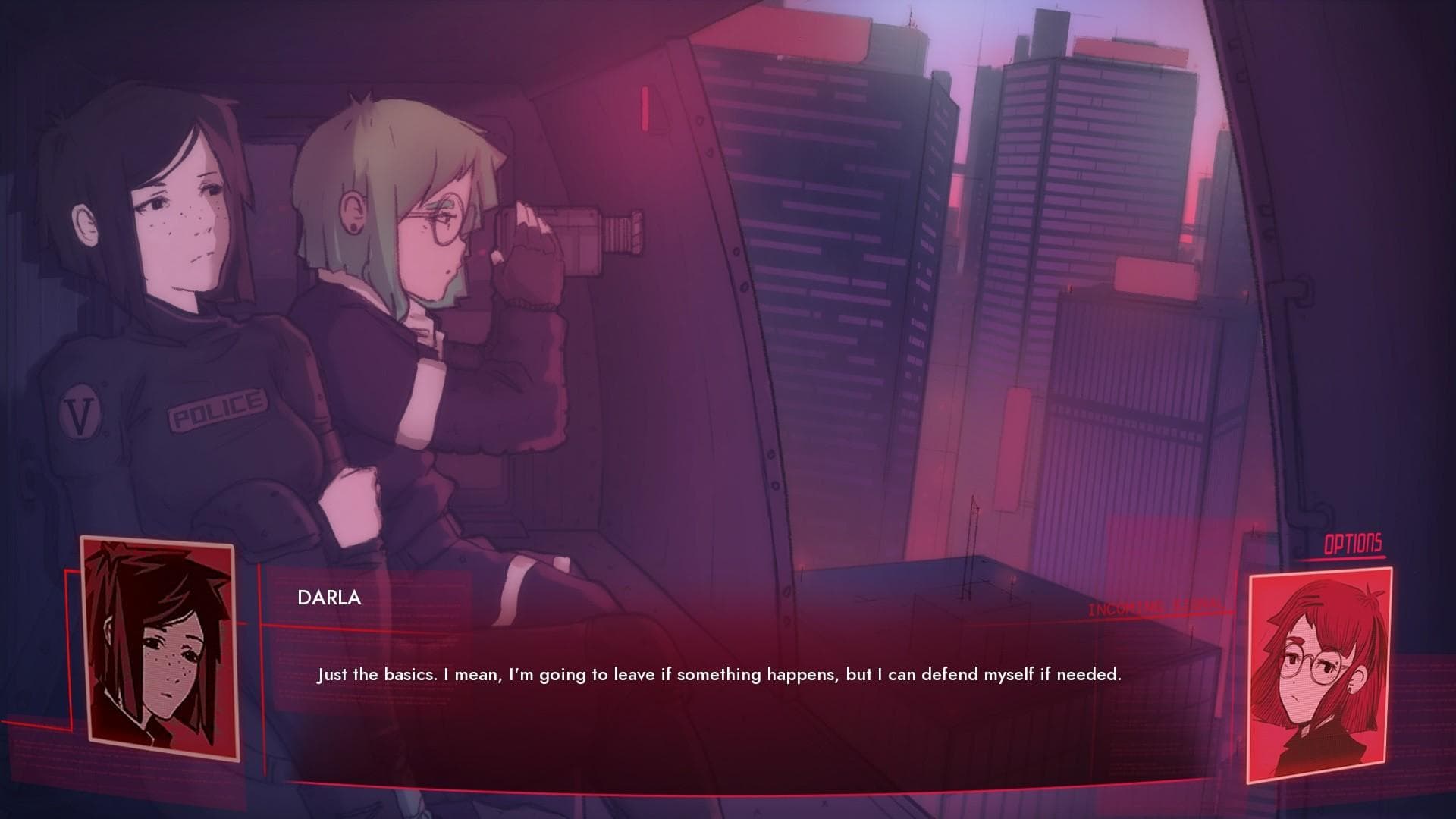
While dialogues and thoughts in the first person form the primary storytelling method, they are not the only ways through which the story is told. Instead of only showing text after text, Synergia includes segments that occasionally require a little more interaction from the player. These sections not only serve as refreshing breaks from the regular text screens but also feed players with minor information that is still relevant to the overall world. Their integration into the narrative is very natural and fluid as well. Furthermore, due to this visual novel playing more like a kinetic novel with its largely linear plot and very few choice points, the addition of these sections has helped to keep things from getting overly boring.
Changes in point of view have also been used sparingly to inject fresh perspectives into the story and gently shuffle up the pacing. These extra perspectives have added so much value to the overall experience that I wish there have been more post-ending side stories told from a few more major characters’ viewpoints. There are simply many well-written interesting characters whose backstories, thoughts, and feelings I would like to further learn about.
On the topic of pacing, a key point that makes or breaks a thriller story, Synergia has good pacing that sadly comes undone towards the ending. The suspense in this thriller visual novel builds up fairly nicely with its well-paced events. That is until a point where the information dump feels like an avalanche of boulders being unleashed, which promptly flattens the blanket of suspense. After that point, the deflated suspense does not quite pick itself back up anymore even though there remain a number more truths left to uncover. Luckily, this occurs only close to the end; the thrill was fun while it lasted.
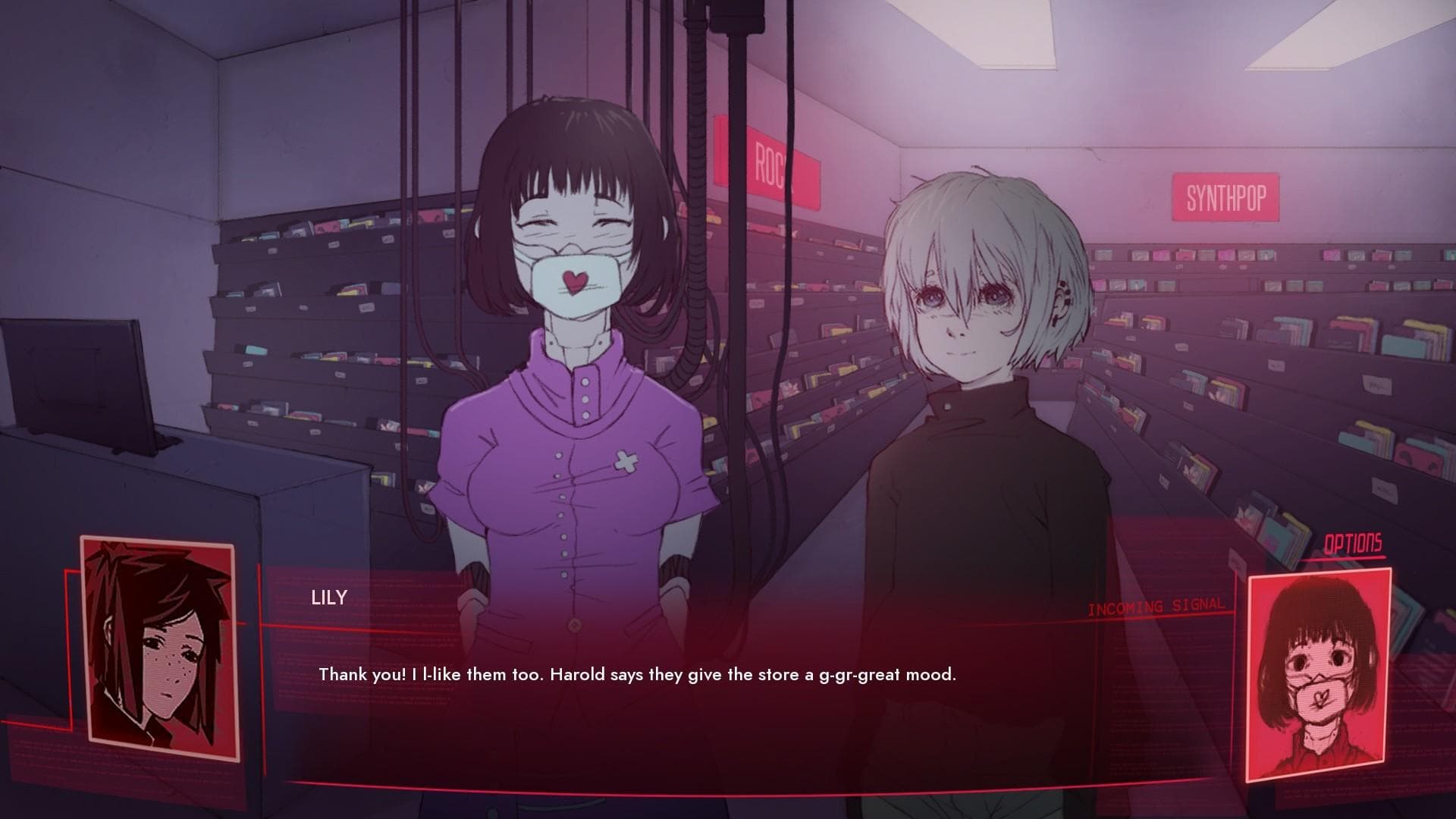
At the beginning of each new chapter, a thought-provoking quote is displayed alongside the chapter title. Most of the quotes are related to the themes found in this cyberpunk story, and at times they help to set a general mood for the chapter while other times they hint at a topic of interest in that chapter. However, they feel mostly cryptic because: one, their contexts are not explained; two, it is not always obvious how they are actually tied to the chapter they appear in; and three, Latin phrases are not translated. The quotes may be trying to add something meaningful to the game but due to their weak connections to the narrative, by the time I reached the end of a chapter, I could never recall the quote that was shown initially.
All in all, Synergia is a solid read with plenty of information, most of which is consistent even if it may get quite technical, packed into this six to nine hours long game. The only definite plot inconsistencies I have spotted are regarding how much in-game time has passed, such as the story claiming ten days to be “over two weeks”.
Writing: Overall quality.
Now, to the mechanics of writing itself — it is passable. Sentences are typically smooth and short enough for easy comprehension. The text may be littered with minor typos but they are mainly just missing full stops. Grammar mistakes can be found too, though they are usually not very distracting. However, there are sentences with weird phrasing that altered the intended meanings completely. For instance, Cila leaving a particular place “walking backwards” conjures up an image of Cila literally walking backwards when all she wants is to return the way she came. In another scene, a character puts their hand “in” another’s mouth to silence the latter. That… is certainly one way to shut someone up but I imagine placing the hand over the mouth should be sufficient to do the trick.
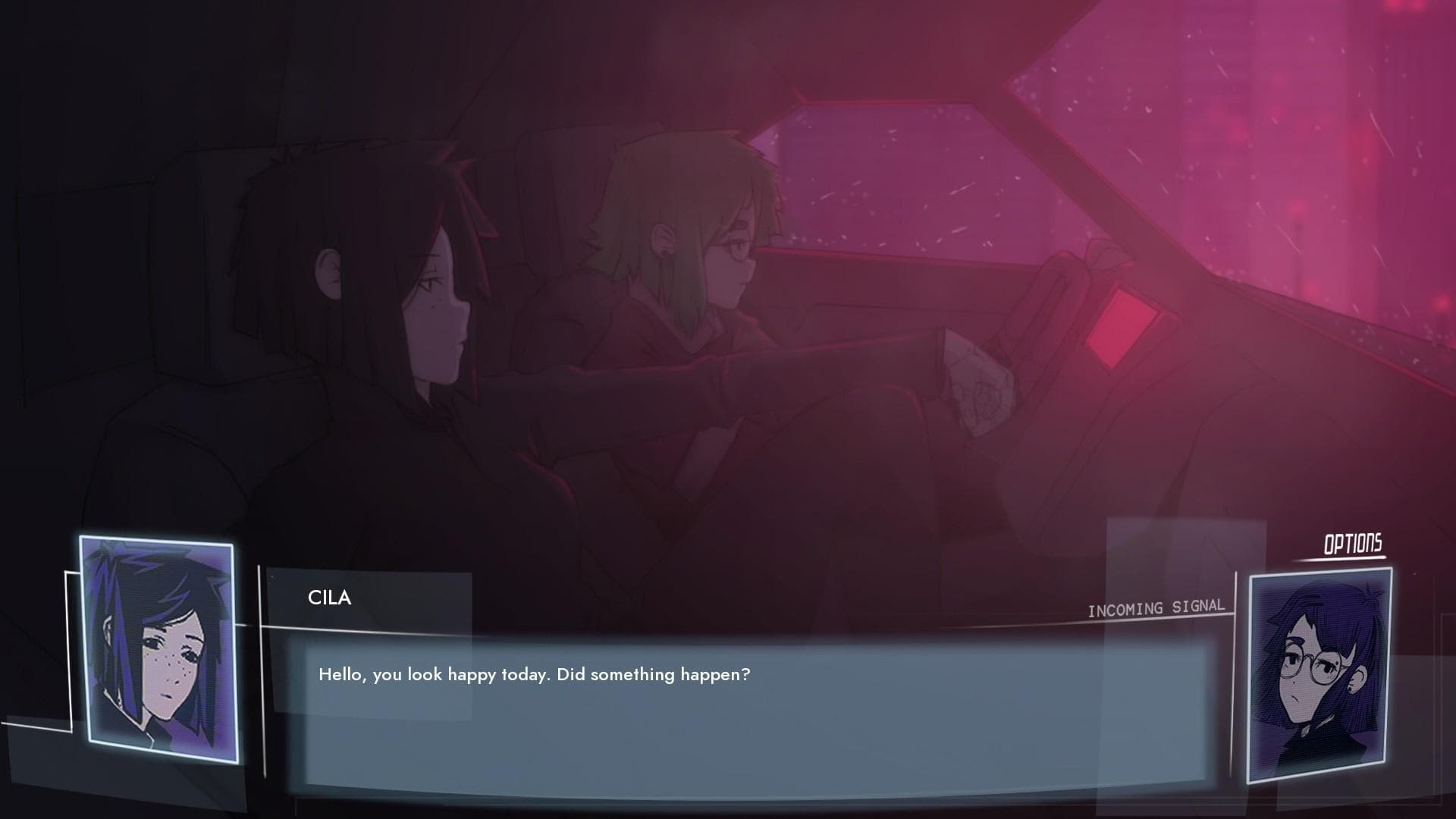
Pronouns confusion is another thing that has made some dialogues perplexing to read. On one occasion, Yoko, who is already established to use she/her pronouns, is referred to with “his”. Cila and Yoko also apparently cannot agree on the pronouns to use for a particular android, and they end up using a mix of both “he” and “she” in their exchanges regarding that android.
Something else that bothered me is the decision to use visibly accented speech for Yoko when nobody else in the game has the same manner of speech. Perhaps it is done so that Yoko would sound punkish, but it does seem inappropriate, considering that she is the only character that the story has actively hinted to be an Asian. Even other punks in Bohemius do not talk the way she does. Surely she is capable of talking in the same way as others while maintaining her unique brand of informality?
Art: Character sprites, CGs, and bugs.
Art in Synergia is drawn with an anime style. Except for the protagonist, everyone who has spoken in the story has a character sprite. The sprites are not animated but they have different facial expressions, poses, and outfits. Darkened versions are even prepared for use during times when the characters are inside an unlit area. Needless to say, a lot of care has been put into ensuring that every character sprite follows even the most minute changes in the story.
Not counting the variants, there are slightly over fifty base CGs in total. In this visual novel, CGs do not portray only the iconic moments. They act more like panels of a comic book that help bring the individual scenes to life. In spite of its nice range of composition, a small number of the CGs contain a noticeable error of Cila’s left mechanical arm being drawn as a normal hand.
Minor bugs are also noted with the UI. Specifically, the left and right arrows on the gallery screen do not work as expected; the right arrow loops through pages one to nine only, and the left arrow goes to twelve, instead of the last page, from one. Moreover, one CG remains forever locked under the gallery screen.
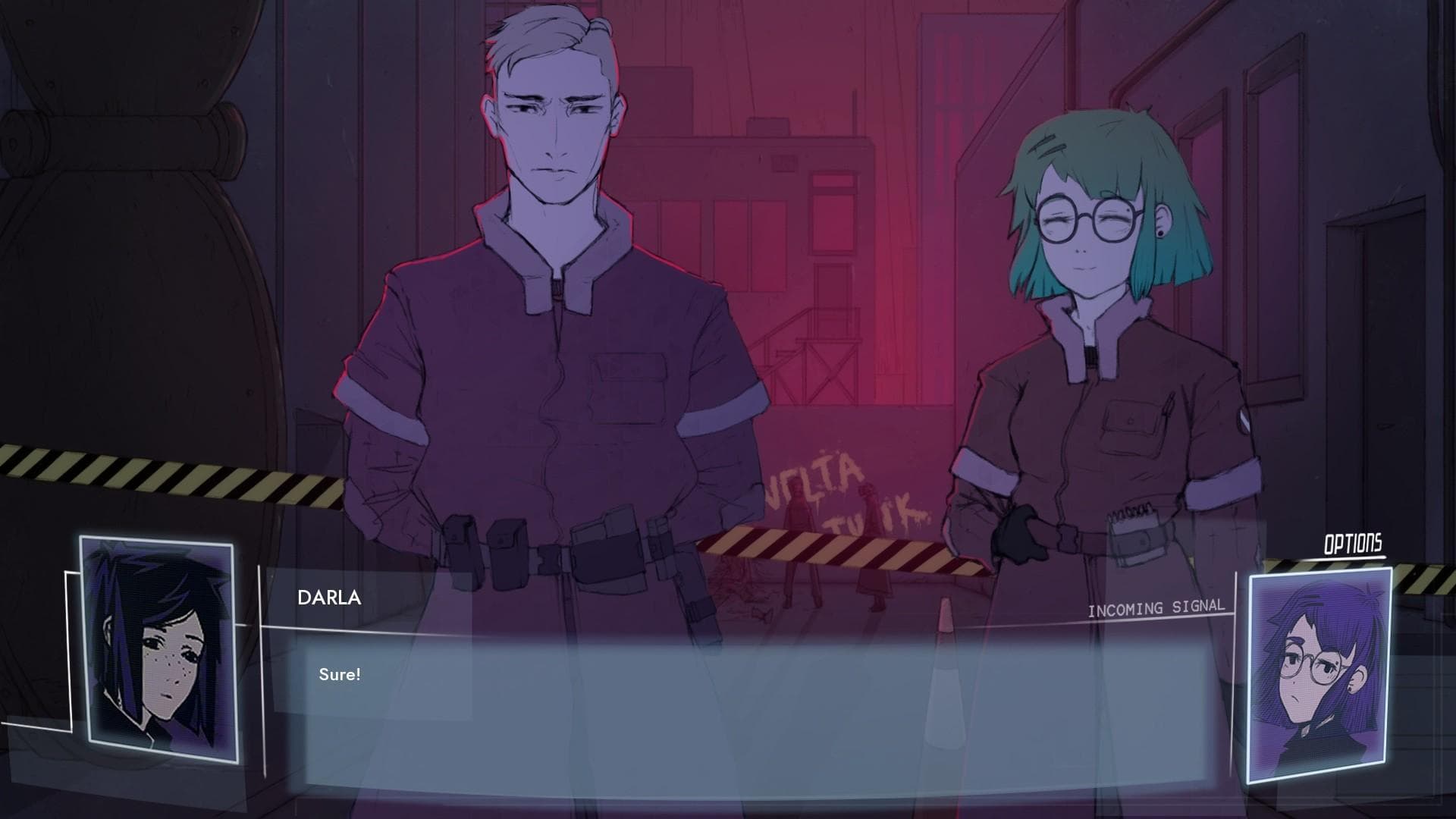
While the visual aspect of Synergia has been handled with flair, some improvements could still be considered, especially for the UI. First, the number of the currently selected page on the save and load screens could use the same highlight effect that is applied to the page numbers on the gallery screen. Next, spaces could be added between the name and vertical bars on the incoming call banner; I have initially misread those vertical bars as part of the caller’s name as they look similar to the capital letter I. Finally, a small quality of life improvement would be for the history log to show the last read line first.
Audio: Immersive audio work with captivating sci-fi beats.
Just as much care has been put into the visual aspect, there has been as much thought put into the audio aspect. Sound effects (SFX) are used generously and aptly throughout to provide an unforgettable audio experience. An audio work that stands out to me is the muffled effect used on the background music for scenes that took place in an enclosed room situated at a corner inside a nightclub. I have only ever found one SFX to be annoying and that is the heartbeat that will continue to beat audibly till it finally reaches the end of its track length.
With cool synthetic beats and unique soundscapes, the music in Synergia pleasantly captures a futuristic feel. What I love about the whole soundtrack is how strongly the compositions express moods ranging from serious to mysterious. My favorite tracks are those that effectively heighten the thrill of this thriller visual novel, which means the majority of them.
Verdict
Unarguably, there is a substantial amount of content found in this short cyberpunk story, from its world to its characters and themes. There is also nice suspense, steady relationship building, and a beautiful yuri romance. Topped with wonderful art and an entrancing soundtrack, Synergia makes for quite an enjoyable and gripping game.
Nevertheless, it should be noted that while this title is a visual novel, it does not feature many choice points and endings. The full game can be easily completed within two playthroughs, so those who are expecting to make more decisive choices or see more branchings may be disappointed by this largely linear setup. But if one does not actually mind that, then I say:
SYNERGIA IS RECOMMENDED.
Purchase: Humble (PC/Steam)
If you would like to see more Visual Novels, you may be interested in our review of Perverse Incentives.
Many thanks go to Top Hat Studios for a PC review code for this title.
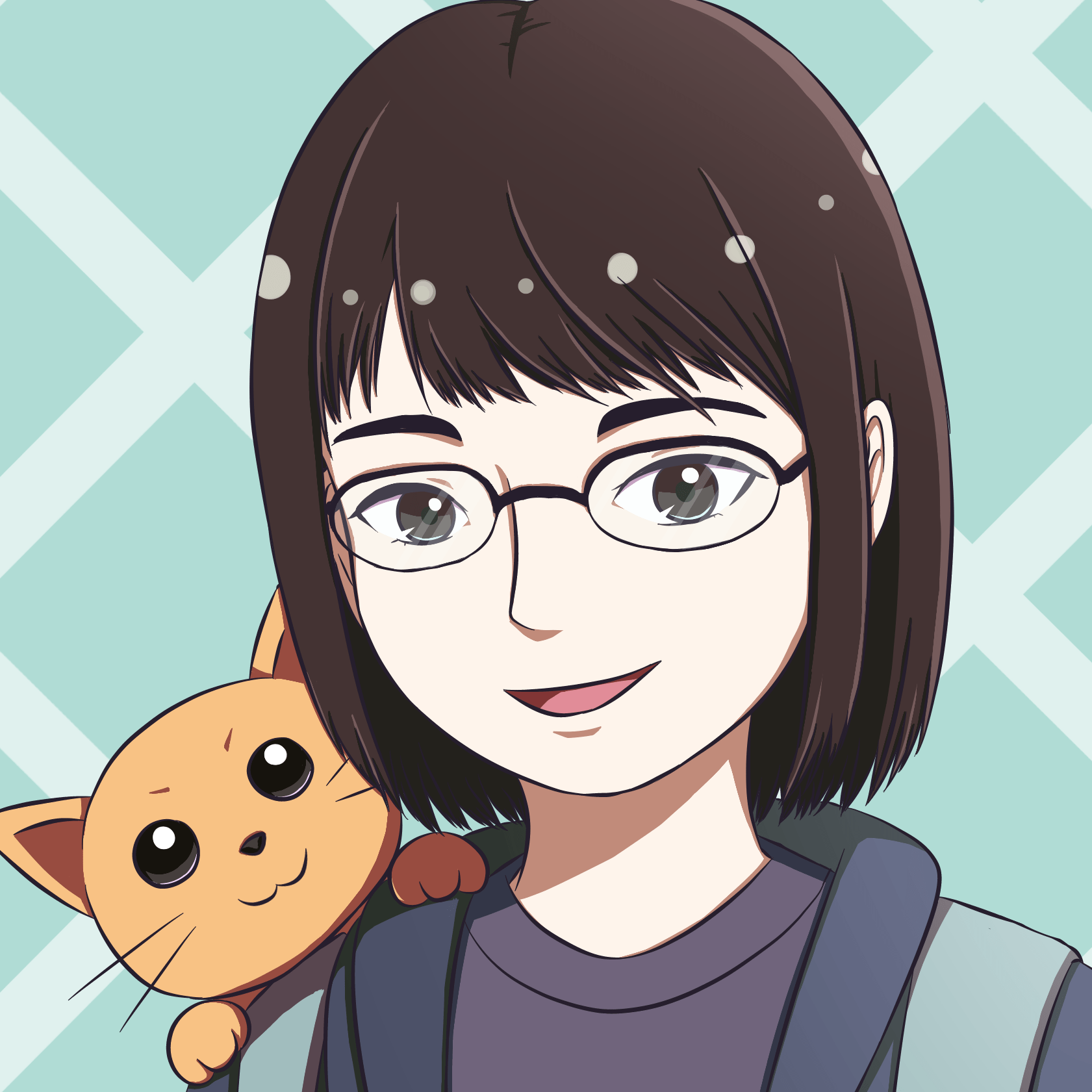
A person with many hobbies (and even more WIPs), KuroKairin plays, playtests, and reviews PC games. She loves games with good stories that bring her on an emotional and thought-provoking journey. Her favourite genres include otome visual novel, point and click, puzzle, and RPG. Follow her @KuroKairin.

